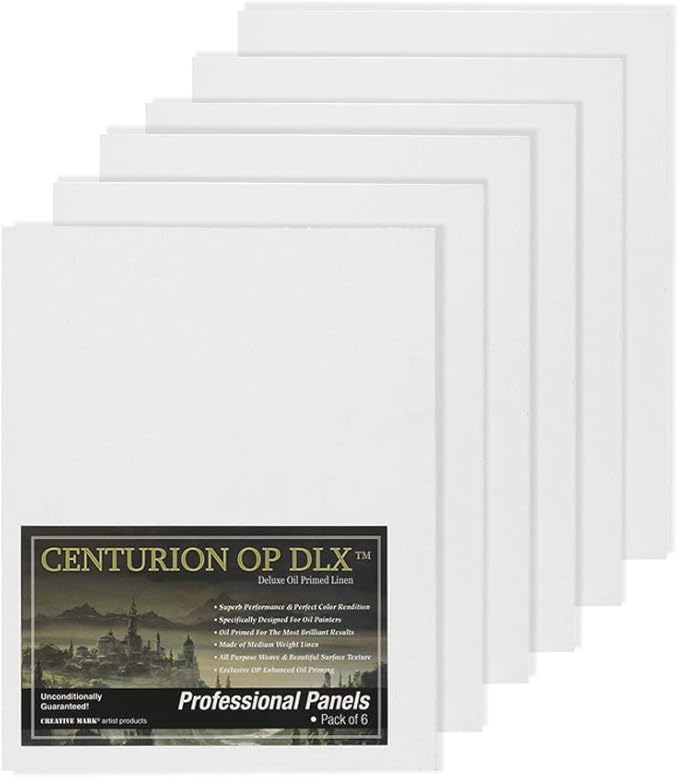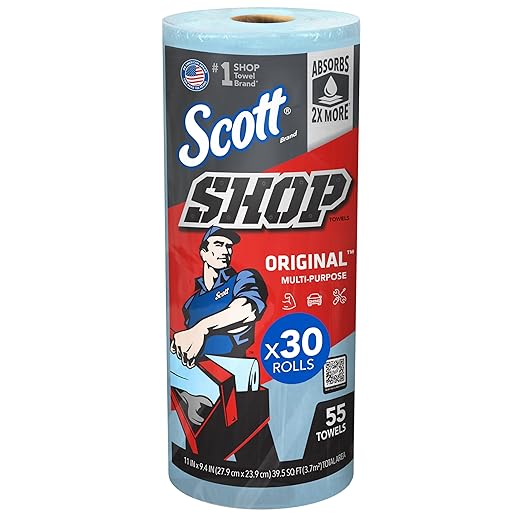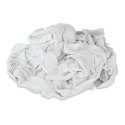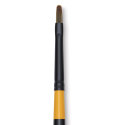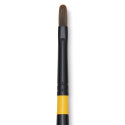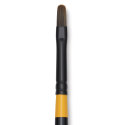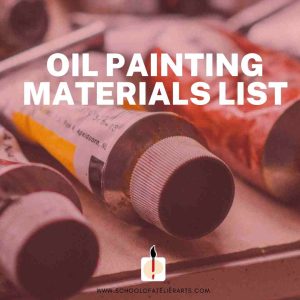
When starting out, having the right oil paint materials list is essential for creating successful artwork. So many students purchase inferior or unhelpful materials, sabotaging themselves and their artwork before they even start.
Introduction to Oil Painting Materials
Unlike watercolor, tempera, or acrylics, oil paints offer unparalleled richness, depth, and flexibility to the painter. Unfortunately, many people are confused by the materials needed for oil painting and avoid it altogether, causing them to miss out on a rewarding art form that has lasted millennia.
Despite popular beliefs, good oil painting materials are not that expensive if you are judicious in your paint selections and take good care of your materials.
In this article, you will discover our vetted oil paint materials list with brief descriptions about why you need each item and how to use them. We’ll go over how to select oil paints, the best palettes, and why a filbert brush is your best friend.
The Department of Aesthetics Blog is reader supported. When you purchase through the links on our site, we may earn affiliate revenue. Please note that SAA is not responsible for your studio safety, and that you should make sure to research how to safely use all studio materials.

Oil Paint
Oil paint is made from pigment mixed most commonly with either linseed, safflower, or walnut oil. The oil creates a binder that adheres the pigment to your painting surface.
Acrylic paint uses plastic as a binder, and watercolor usually uses gum arabic as a binder. The pigments between all these different kinds of paint are actually the same. If you buy cadmium red watercolor, cadmium red oil paint, and cadmium red acrylic paint, it is the same pigment being used. What is different is the binder.
As someone who is increasingly concerned about microplastics in our environment, I avoid using acrylic paints and acrylic primed painting surfaces which use plastic as a binder.
There is a reason oil paint has been around for thousands of years. It is useful, long lasting, easy to work with, and creates beautiful results. Welcome to the world of oil painting!
Please note that I do not advocate for any particular brand. As long as you choose professional grade paint there are many wonderful options. I have linked my current favorites.
Student Grade vs. Professional Grade Oil Paint
This difference between student grade paint and professional grade paint comes down to the binder (and fillers) used for these paints.
Pigment can be very densely packed within a paint, which creates a rich paint with high coloring power. Professional grade paints tend to have the highest pigment density available for that pigment.
Or, paint manufacturers can add a filler to spread out the expensive pigment a bit. This allows them to get more paint for less costly pigment.
Although the cheaper student paints are attractive to financially struggling students, I find it is rarely worth it to cut costs on paint.
When you learn how to paint using atelier methods, you are not using so very much paint every day. Even if you paint 6 hours a day in an atelier, it is unlikely that you will go through all your new tubes of paint within 6 months.
So although it is more of an up front expense to purchase professional grade paints, if you are painting like an atelier artist and not a modern artist covering 6 foot tall canvasses, the small amounts of paint you are using justifies the higher quality paint cost.
For this reason, all recommended paints found here are professional grade paints.
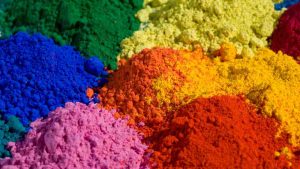
Types of Pigments
Paint is made from many different kinds of pigments. The pigments themselves have different properties that oil painting students should be aware of.
Earth Pigments: Some pigments used in paints are simply refined dirt. Raw Sienna was originally a yellowish dirt from the town of Sienna. Yellow Ochre, Burnt Sienna, Terra Verte, etc. are all versions of refined dirt mixed with oil.
Heavy Metal Pigments: Some pigments use heavy metals. Examples include cadmiums and lead whites. These pigments should be handled with care to make sure you never accidentally ingest them. Again, it is not being oil paint that requires careful handling, it is the pigment itself which can be purchased in many forms of paint.
Organic Pigments: Some black paints that are made from soot or burning animal bones. Carmine red uses crushed cochineal insects as its pigment, but sadly it is fugitive and the color diminishes with exposure to light.
Synthetic Pigments: These are modern pigments that have incredible lightfast properties and were often developed by the car manufacturing and makeup industries. They tend to have very intense color strength and resistance to dimming over time. Examples include paint colors with the word “quinacridone” in them.
Recommended BASIC Oil Paint Materials List
The School of Atelier Arts believes in simplicity and approachability in all of our painting classes. That is why we keep our palette recommendations simple. We want our students to produce the greatest artwork with the least amount of confusion. We have found that these pigments give students great results. Remember, you do not need 100 paints. You need a handful of paints that will get you where you want to go in your painting journey.
Want direct coaching on how to use this simple palette to create beautiful artwork? Join our online atelier, Ateliyay! Painting Bootcamp. For the fraction of the cost of other ateliers, you can learn online at your own pace with our incredible instructors and flexible schedules.
Old Master Oil Paint Materials List
This is a tricky palette to narrow down as there are many variations of it that artists used throughout history. This is one example of a minimalist Old Master Palette using just 4 colors, and often referred to as a “Zorn Palette” due to this artist’s persistent (but not exclusive) use of it. I’ve included the more historic pigments in this list, but almost any red, yellow, white, and black can be used to make up a “Zorn Palette”.
Brushes
Brushes come in many shapes, sizes, materials, and crucially, quality. Through more than a decade of teaching, I have found one type of brush superior to all the rest for beginner students.
The Versatile Filbert
At School of Atelier Arts (SAA), we emphasize using synthetic filbert brushes because they combine the best of flat and round brushes. They allow for both broad strokes and fine details, making them the most versatile option for classical and contemporary painting. Their soft edges both blend smoothly and can make sharp lines depending on the angle of the brush, making them perfect for using just 1-3 brushes for an entire painting. We like to keep things direct and simple at SAA.
Brush Recommendations
The Rosemary Brush Company makes outstanding quality brushes which are each made by hand. I especially like their synthetic Ivory Series. Due to their exceptional quality, they are a little pricer than other options and are best to invest in once you have some oil painting experience.
My favorite brushes to recommend to students are the Utrecht Synthetic Filbert Brushes. This is what I encourage students in our online painting classes to purchase for their first oil painting materials setup:
Palettes
Palettes are an essential tool for the classically trained painter. Here are the different options available and our recommendation to add to your oil paint materials list.
Palette Options
- Wooden Palette – Traditional and great for mixing, but requires prepping the palette carefully with layers of linseed oil. I love the romanticism of a good wood palette. More importantly, I think this is the best palette for students as they can hold their palette up close to their canvas when mixing colors.
- Glass Palette – Some students really love using a glass palette due to its larger size and the ability to set the glass on a table in front of you. (You do not want to hold a glass palette! HEAVY!) However, as an experienced atelier instructor, I dislike that their color mixing is done so far away from their canvas. I feel this is a disadvantage for seeing color as a beginner.
- Disposable Paper Palette – Convenient for quick setups and cleanups but lacks durability, and frankly, is a huge pain in the rear. It moves, tears, and makes mixing colors annoying. A wood palette is much easier to clean than most people realize. You can simply scrape off the paint with a palette knife and wipe it with a paper towel. That’s it. Don’t be afraid.
Palette Recommendation
I’m obsessed with these super thin (and therefore light!) wood palettes. I find they last me a long time as long as I care for them well. They to have a tendency to warp, but this is easily fixed by making sure you oil both sides of your palette after use.
Keep It Simple: Avoiding Unnecessary Oil Painting Mediums
It’s tempting to use mediums like liquin, turpentine, and alkyds, but at SAA, we advocate for keeping things as simple as possible. The less you have to think about that is not actually painting the better.
Also, I believe in letting oil paint act and behave like oil paint. It is not watercolor, you do not need to thin it as if it were. It is not acrylic, so stop adding dryers to your paint to make it act like acrylics. It is oil paint. Let it be oil paint.
Instead, use paint straight from the tube, occasionally adjusting with a small amount of refined linseed oil if the paint out of the tube is excessively thick. Overuse of solvents or mediums can create a nasty smell, introduce unknown chemical elements into your studio, and can create unknown safety hazards as many secret painting mediums have unknown substances in them. Keep it simple, and let the oil paint do its oil paint thing. It is, after all, oil paint.
Painting Medium Recommendations
Gamsol is a popular solvent in oil painting circles because it is formulated to evaporate at a lower rate than other additives. If you insist on having an additive to your paint, this is the one I recommend over all others and you will find it on our oil painting materials list.
I encourage students to only use this to thin paint when drawing on a canvas. That’s it. Even then, I am starting to transition students to drawing directly with pure paint instead of thinning it. The more stinky extras you eliminate from your painting practice the better.
Refined Linseed Oil is a useful medium to have around your studio, but with the caveat that you need to be very careful with how you use it. Leaving a rag soaked in linseed oil crumpled on your studio floor may cause it to spontaneously combust. This is why when I use linseed oil to prime my palettes, I immediately dispose of the cloth flat in an outside garbage can away from anything flammable. Please note that SAA is not responsible for your studio safety.
Linseed oil may also be added in very small amounts to thin especially thick paint.
Make sure you only use refined linseed oil, not commercial grade linseed oil. It is important that all impurities are removed from your linseed oil to ensure it does not darken your painting over time.
Palette Knives
There are good palette knives and bad palette knives. You can tell simply by holding one and bending the blade.
A good palette knife offers flexibility. It’s blade is thin yet durable. A bad palette knife is brittle and breaks under pressure. It might also be very thick and unwieldy.
Please do not use those dumb plastic palette knives, they are a nightmare for serious painting.
If you are a school teacher looking to put a class set together, invest in a smaller number of good quality palette knives for students to share instead of the worthless plastic ones that do not do their job well at all.
I have found that a single palette knife is sufficient for most purposes, especially beginner painters learning to use one for the first time. If you have many palette knives, there is a tendency to lose them. If you have one palette knife, you keep track of it.
Palette Knife Recommendation
I like this size 5 smallish trowel-shaped palette knife from Blick.
Painting Surfaces
Ah canvasses, canvasses. So many to choose from. But all canvasses are NOT created equal my friends.
Cotton Canvas
Cotton canvasses were not widely used by artists until the 1800’s when mass manufacturing made the material more broadly available.
As a canvas choice, cotton is often cheaper than linen. But it is also often much more course than many linens. Low resolution surfaces tend to be very difficult for students to learn on. I have witnessed many student projects fail simply because they could not control their paint on such a highly textured surface.
Students are tempted to use cotton canvasses when learning how to oil paint due to its lower cost, but this comes at its own price. This is because each support you practice painting on teaches you something about material handling for that support. When you switch to a different type of canvas later, you have to relearn your paint handling skills.
This is why I encourage students to use professional grade paints and canvasses as early as possible in their learning journeys. The cost difference is not so astronomical, but the benefits of learning on materials you intend to use for the longevity of your career has incalculable benefits.
Linen Canvas
Linen canvas is the preferred surface used by most easely painters for the longest period of time. There are probably good reasons the Old Masters had for that.
My reasons for recommending linen canvasses is that we have evidence in museums that it upholds reasonably well over long periods of time. It is a natural substance that we know for sure does not interact adversely with any of the pigments that were used historically. Its finer threads and subsequently tighter weave create a smoother painting surface which is especially desirable for students learning how to paint.
Although linen tends to be more expensive than cotton, there are economical options that work quite well for student work.
Canvas Board
Canvas board is a cheaper alternative than stretching canvas or purchasing pre-stretched canvas. It is also sturdier to work with than taping loose canvas to a board. I recommend this option for beginner oil painting students.
Centurian oil paint board
Other Supports
In addition to canvas, some other support options include wood and metal. I do not use these supports in my own painting practice, and therefore will not offer recommendations on these materials.
Oil vs. Acrylic vs. Primed Canvas
Now that you have selected a canvas, you need to consider the primer. This is what rests between the cotton/linen/other support and your painting on top of it.
I am generally against using materials that we do not have long term information on. As plastics (and therefore acrylics) were not made widely available to artists until the second half of the last century, I do not trust that we know what their true longevity may or may not be.
We do have a substantial track record that oil primed linen will last centuries when treated properly. Therefore this is the only type of primed canvas I recommend to my students.
Unprimed Canvas: Do not do this to yourself. Especially if you are a beginner. There is no reason to learn an entire new oil painting skillset that is required to prime a raw canvas well. Why mess with rabbit skin glue, weeks of drying time and sanding, etc. when there are really wonderfully primed canvass options readily available? This is art materials geekery territory. If you want to learn how to paint, do that first then circle back to this.
Canvas Weaves & Gesso Layers
Canvasses come in a variety of weave densities. Oil Primed Portrait Linen is generally considered the smoothest painting surface with tightly woven fibers. To my knowledge there is no standard for measuring weave in painting canvas, but most producers of painting linen will list in their descriptions how smooth or rough a surface is.
The smoothness of a painting surface is also determined by how many layers of gesso are applied to it. The more layers, the smoother the surface.
Pre-Stretched vs. Hand Stretched Canvasses
For beginner students, I recommend using canvas board or pre-stretched canvasses. Please don’t distract yourself from the very difficult task of learning how to paint by going on unnecessary side quests like stretching canvas. Learn how to stretch canvas once you have a solid set of painting skills under your belt.
Some students dislike how loosely pre-stretched canvas tends to sit on the frame. The little “keys” on the back of the canvas can be inserted on the back side to tighten the canvas.
Loose Canvas
Students often overlook the usefulness of loose canvas. You can cut it easily to any size you need. It is less expensive than stretched canvas. If you paint something you especially love, you can matt it under glass like a drawing, or have it dry mounted to foam core at a frame shop and frame it the same as any other painting.
Canvas Boards
Canvas boards are not often included in oil painting materials lists, but I think that is a mistake. Canvas boards are economical, offer a firm support for framing, and are easier to store than fully stretched canvases. I find them to be a very good compromise for students between the time, energy and expense of stretched canvas and the less professional looking loose canvas.
SAA’s recommended oil primed linen STRETCHED CANVAS, LOOSE CANVAS, & BOARDS:
For beginners, Centurion makes affordable oil primed linen with a smooth surface. They also make the most acceptable versions of pre-stretched canvasses I have tried.
Sometimes students find the surface of Centurian canvas too smooth, in which case I recommend Clausens. Clausens is my favorite oil primed linen for professional work. It has a wonderful weight to it and stretches well on bars. It comes in rolls and must be stretched by hand onto stretcher bars for professional paintings. It is fine to cut up into small pieces for studies as well. Although pricey, it will last a very long time.
Easels
Next on our oil painting materials list is easels. You don’t need 15 easels. You need one maneuverable easel that accommodates the majority of the work you will ever make in your career.
There are big expensive H-Frame easels, and smaller pack-and-play plein air easels. Table easels. All the easels.
However, I try to convince my students to keep their setups as simple as possible. Learning how to paint is already challenging. Pondering an infinite number of easel options is a distraction.
Easel Recommendation
The easel I most recommend to students AND my professional peers is the Testrite Aluminum Easel. It is metal and durable, It’s easy to fix. It collapses quite small. It’s not terribly heavy. I can easily take it with me plein air painting (although not for extended plein air painting hikes, more the type of park and paint). Yet, it is sturdy enough for my clumsy self to stumble into it without knocking it over in my studio. It also has a small footprint ideal for tight studio spaces. And it is one of the more affordable options on the market. If you are especially tall, they make an extension that I recommend getting as well.
List of Miscellaneous Oil Paint Materials
Automotive Blue Paper Towels
These help keep paint off your hands as they were designed to absorb oil. Regular paper towels allow oil paint to soak through and get on your hands.
Dish for Storing Brushes in Linseed Oil
This is the cheater’s way of not having to wash brushes. Wipe off excess paint with paper towels after your painting session. Then, simply submerge the brush end of brushes in oil to keep them from drying out. It helps to slightly elevate one end of the dish at an angle by placing a roll of tape under one side.
If you want the non cheater way to wash brushes, you can learn how to wash brushes here.
Fire Proof Trash Can
This is a good safety measure to have in your studio. Rags soaked in oil can spontaneously combust. Always use oil in minimum amounts and never leave an oil soaked rag lying around. Please note SAA is not responsible for studio safety.
Cotton Paint Rags
These rags are useful for the wipeout technique, as well as other studio purposes.
Artist Tape
An essential for taping canvas to boards and other studio needs.
Foam Core Boards
These lightweight boards are superior to heavy wood ones. They are easy to move around and are great for taping loose canvas to for painting studies.
Thin Black Sharpie
These are great for transferring drawing as they do not dissolve when painted over.
Tracing Paper
Tracing paper is useful for transferring drawings to canvas.
Complete Oil Painting Materials List (With Links!)
By choosing high-quality materials, and avoiding unnecessary additions to your studio practice, you set yourself up for success in your artistic journey. Here are our complete list of oil painting materials recommendations.
Titanium White
Cadmium Yellow
Cadmium Red
Ultramarine Blue
Ivory Black
Brushes

The post Oil Paint Materials List appeared first on School of Atelier Arts.



